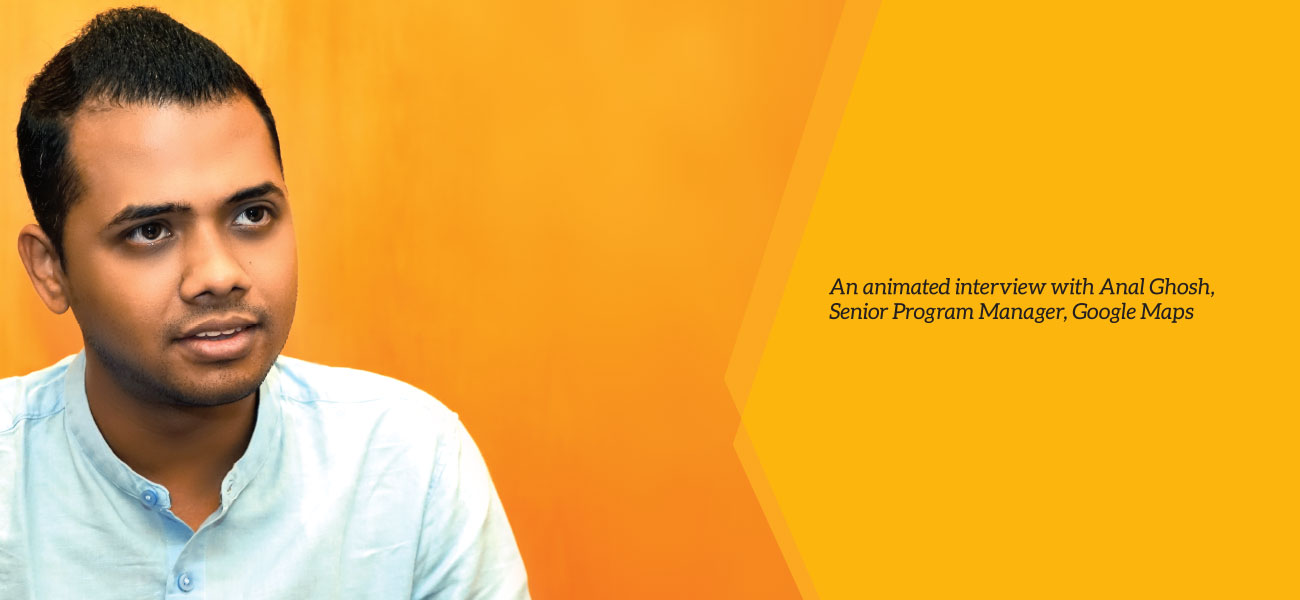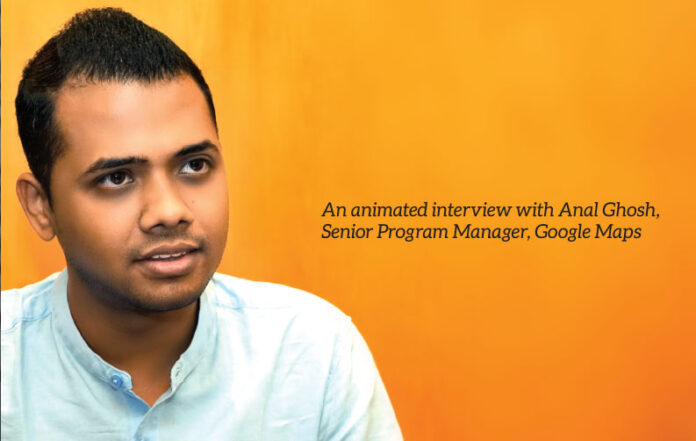
Anal Ghosh is a Senior Program Manager in Google Maps, Google Hyderabad, India.He earlier worked in Deloitte Consulting as a senior consultant from 2011 up to 2014. Before Deloitte, he worked in McKinsey & Company as an analyst for more than three and half years He graduated from St Xavier’s in Statistics. After that he completed his MBA from Indian School of Business.
Decked in a white shirt and blue jeans, Anal Ghosh entered the conference room at Dhaka Westin on a rainy Friday noon in casual manner. In his late 30’s, he has this boyish look that emanate charm and confidence both at the same time. Told about that, he smiled and said, “Let’s talk business.”
In the next 30 minute or so, the Fintech team talked with this young Googler to learn about one of the most used products of the tech giants: Google Maps.
Here is an excerpt of that interview for our readers.
Can you tell us something about yourself? How do you end up working in Google?
I am currently working in Google as a Senior Program Manager. I am posted in the Google Maps division. I have been with this company for over five years now. My posting is in Hyderabad, India. I started my journey here in Google in April 2014 as a program manager of maps operation and worked in that capacity for more than three years.
Before joining Google, I worked in Deloitte Consulting as a senior consultant from 2011 up to 2014. Before Deloitte, I worked in McKinsey & Company as an analyst for more than three and half years. I started my professional career there.
Academically I completed my bachelors in Statistics from St Xavier’s and my MBA from Indian School of Business.
Now that you are working as a senior program manager in Google maps division, what are your responsibilities here?
If you look at Google maps as a product, you will see that it literally has a ubiquitous presence worldwide. It is available almost in every country in the world. Google initially built the product for the North American and the European countries but now the product is being developed and fine-tuned for almost all the countries. My role and responsibility focuses on to build and develop the product for the market in South Asia that includes countries like India, Bangladesh, Pakistan, Srilanka etc.
People in different parts of the world have their own unique ways of life and while developing a product like Google Maps, we have to keep those unique lifestyles in our mind. The traffic jams that you will find in a South Asian city, the mixture of slow moving and fast moving vehicles, the laidback lifestyles of people, these are unique in this part of the world those aspects have to be considered for fine-tuning our products. My responsibility is to figure out those unique aspects of the product and incorporating those to make it better customized for the people of this region so that they can reap out the maximum benefit out of this product.
If we look at most of the western cities, we would find those to be well planned-as if those are cut out of a grid board. But most of the South Asian cities are being developed in an unplanned manner? So in terms of mapping, what are the challenges Google Maps faced while developing its product here?
As I said earlier, the challenges here in the South Asian cities are multifaceted because of the unique lifestyles of people here. There are many roads and alleys in these cities which are even hard to navigate with a vehicle.Besides, the pace of developments in these cities is also higher than many other regions. There are numerous constructions works of buildings, flyovers, metro rails going on in these cities and while mapping we need to update those on a regular basis. So of course mapping in these countries are more challenging but in these era, we have access to literally tons of data. Data obviously help us to take make our map more comprehensive and accurate. We also have different sources of getting data; we sometimes take data from third party. This vast access to data helps us to fine-tune our product.

Google recently added some new features in its Google Maps product for Bangladeshi users? Can you tell us something about those?
We recently added three new features in our Google Map product and we announce that in our Bangladeshi market through a program. One of those features is the navigation mode for motorbike riders. Bangladesh has become a country of motorbikes, with more than half the country’s households owning a motorcycle as a common way to get about and cut-through traffic. Motorcycles have specific needs. They can take routes that cars can’t take such as narrow roads and alleys. There are also some roads (e.g. highways) where two-wheelers aren’t allowed. Motorcycles often move at different speeds than cars. The new feature addresses these issues. The new navigation mode for motorcycle riders feature delivers more accurate travel times based on machine learning models that reflect motorbike speeds. Not only turn-by-turn navigation, but the direction results also include Google Street View image references, to help people with pre-trip planning and remember their routes.
Another of our features is turn-by-turn voice navigation in the local language. Google Maps voice navigation language is independent of your device’s language setting, so you could have voice-guided navigation in Bangla while continuing to use the Google Maps app in English. You can also change your phone language settings to “Bangla (Bangladesh)” and Maps voice navigation will automatically give you directions in Bangla.
The third feature is a safety feature built into Google Maps. Now, after searching for your destination and getting directions, you can enable this experience by selecting the “Stay safer” and “Set off-route alerts” option.
If your cab, rickshaw or ride-sharing driver deviates more than 0.5km from the Google Maps suggested route, your phone will buzz with a prominent notification, and you can tap it to see where you are compared to the original route. Then, you can also choose to share your live trip with friends and family directly from that screen so they know you are off route and can keep track of your journey, and take appropriate action if required.
Google has been investing aggressively in maps capabilities in Bangladesh. Since January 2018, Google has added more than 50,000km of roads, more than 8 million buildings, and more than 600,000 points of interests on Google Maps across Bangladesh.
Google Maps give pretty accurate data about the real time traffic. Can you tell us how does it do it, obviously in laymen terms?
This is because the Google Maps app on Android and iOS constantly send back real-time traffic data to Google. The data received from any particular smartphone is then compared to data received from other smartphones in the same area, and the higher the number of Google Maps users in an area, the more accurate the traffic prediction.
Using the historical data it has compiled over the years and traffic data from mobile devices using the Google Maps app, the company is able to create models for traffic predictions for different periods. For example, the modelling techniques would be able to predict that certain roads would experience more traffic during rains than other times of the year. Google also takes traffic reports from transportation departments, road sensors, and private data providers to keep its information up to date.
But the accuracy of location data is unmatched only because of its users, since the billion Google Maps users on the road act as sensors for the app, which make the service as precise as possible. Of course, you can opt out of it by turning off Location Services for Google Maps in Privacy on your iPhone or turning off Google Location History under Location in the Google Settings option.
Privacy of data is a concern worldwide. How does Google tackle the issue of data privacy?
I work in Google Maps, so I can’t speak for the whole company. I am also not in a position to talk about the whole data privacy policy issue of Google. What I can say that Google is very concern about user’s consent about giving access to data. Google gives maximum control of data to its users. For example, in Google Maps, a user can delete his data in the timeline history if s/he wants.








